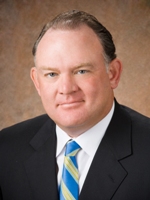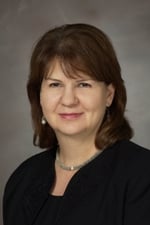
High Residency Match, Yet More Residency Positions Needed
A record 95 percent of this year’s graduating U.S. medical students have matched to available residency positions, yet due to an increase in medical school programs and a pending physician shortage, many experts report, America needs more graduate medical education (GME) residency positions. A bill pending in Congress would increase the number of Medicare-supported residency positions.

Latha Chandran, RN, MPH, said with the length of time it takes to prepare physicians, we must start now to add residency positions.
“It takes between eight and 10 years before a medical student becomes a full doctor, so we have to plan now for what we will need 10 years from now,” said Latha Chandran, MD, MPH, vice dean of undergraduate medical education at Stony Brook University in Stony Brook, N.Y. “We have more of the older population and more insured, and there’s a shortage of physicians.”
Robert Blackman, MD, of HealthCare Partners in Los Angeles, agreed that with healthcare reform, a gap will exist between physician supply and demand, particularly in primary care, as delivery models change and an emphasis is placed on population health. HealthCare Partners is a large medical group participating in the Medicare Pioneer Accountable Care Organization Model.
“If [primary care residency programs] are turning people away because they don’t have room, they either need to add to existing programs or add new programs elsewhere,” Blackman said.
The National Resident Matching Program (NRMP) reports 1,478 more primary care positions were placed in The Match in 2013 compared to 2012, and 99.4 percent of the internal medicine positions were filled, as were 95.6 percent of family medicine positions and 99.6 of the pediatric openings.
Anesthesiologist Edna Ma, MD, of Los Angeles, said students often prefer residency programs for specialties with more favorable lifestyles, such as ophthalmology, radiology, anesthesiology and dermatology.
Mark Smith, president of Merritt Hawkins, the nation’s largest physician search and consulting firm and a company of AMN Healthcare, is encouraged by the increased interest in primary care but cautions that shortages exist in many specialty areas, as well.

Mark Smith, president of Merritt Hawkins, pointed out that the need for more physicians includes many specialty areas, as well as primary care.
“Over 20 medical specialty societies have released reports projecting shortages in their fields,” Smith observed. “If we increase the number of primary care physicians while reducing the number of specialists, we are only robbing Peter to pay Paul. We need to produce more physicians in both primary care and specialty areas.”
NRMP reported 17,487 graduating medical school seniors participated in The Match, a computerized mathematical algorithm to align the preferences of applicants with the preferences of residency program directors to fill the training positions available at U.S. teaching hospitals. Of those, 16,390 successfully matched to first-year residency positions, 78.8 percent to one of their top three choices. In addition, more than 9,000 graduates of osteopathic schools, and international medical schools were matched. All the new residents will start July 1, 2013.
“Match is a wonderful experience for a majority of students,” Chandran said. “It’s important for students to be aware of changes in the healthcare environment and plan appropriately when they apply to places.”
Ma explained that medical students like the predictability of knowing what they are going to do next and can plan. She considers this year’s 95 percent a solid number, and feels that a 100 percent match is unrealistic.
The Association of American Medical Colleges (AAMC) projects a nationwide shortage of 90,000 physicians by 2020. It reported medical schools are on track to increase enrollment by 30 percent and were responsible for the 960 additional medical students participating in the residency match program this year.

Margaret Uthman, MD, said the number of residency programs have not kept pace with increases in medical schools.
“U.S. medical schools are increasing students and new medical schools have formed,” said Margaret Uthman, MD, associate dean of graduate medical education at The University of Texas Health Science Center at Houston Medical School. “We haven’t had a corresponding increase in residency programs.”
Ma explained that the addition of residency positions is “highly controlled and an economic equation. You don’t want a surplus of certain types of providers in a certain geographic area.”
Medicare was set up in 1965 with funding for the direct cost of resident positions, along with a portion of faculty positions, Chandran said. Direct training costs hospitals nationwide about $13 billion annually, of which Medicare supports $3 billion.
Hospitals also receive Indirect Medical Education funding to help defray higher costs associated with patient care in teaching facilities, she added. That support amounts to about $6.5 billion according to AAMC. But since the 1997 Balanced Budget Act, Medicare support for medical education has been capped.
“There have been increases in the number of positions, but hospitals bear the brunt of paying for those,” said Uthman, adding that in addition to the cap, programs are concerned about the effect sequestration will have on residency programs.
Senators Bill Nelson (D-Fla.), Charles Schumer (D-N.Y.) and Majority Leader Harry Reid (D-Nev.) have sponsored the Resident Physician Shortage Reduction Act of 2013 (S.577). It would increase the number of Medicare-supported residency positions.
Meanwhile, physicians involved in training future providers remain concerned.
Uthman reported that hospitals typically will not accept physicians who have not completed residency training on their medical staff, creating a roadblock for students if there aren’t enough positions.
“If you have the number of GME positions fixed and the number of medical students increasing, at some point if there is not a careful balance, there will be medical students not having a residency position and carrying a six-figure loan,” Chandran added.
Many applicants who did not match to a residency position will attempt to find a position through the NRMP Supplemental Offer and Acceptance Program (SOAP). There are 1,041 unfilled positions; most are included in the SOAP.
“They can now apply to 30 programs in the first round,” Chandran said. Programs can then offer available positions to those interested in a sequential manner.
Available positions may not be in the specialty the student desired, but they want to practice and will work to find a position, Uthman said. Those who cannot find a match may take a year off, do research or pursue a business degree.
Ma suggested they also could find positions in industry or in healthcare policy.
They could accept an academic position or become an author, like Michael Crichton, said Blackman, adding, “It’s not that doctors don’t work if there’s not a match.”
© 2013. AMN Healthcare, Inc. All Rights Reserved.


